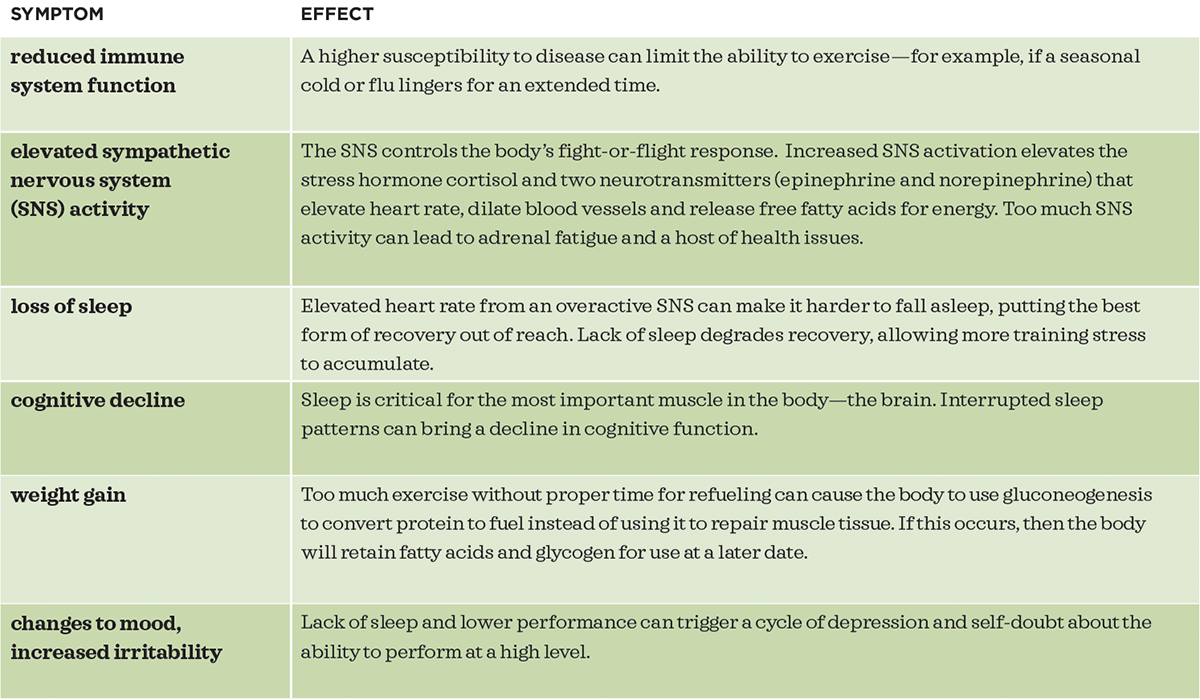
Exploring Exercise Recovery Options
When it comes to balancing your training program, your mindset should be, “Tomorrow’s workout begins with your recovery from today’s.” Exercise recovery heals the pounding, twisting and tearing of physical activity. A well-thought-out strategy for recovery is becoming ever more crucial with the rising popularity of high-intensity workouts featuring barbells, kettlebells, heavy medicine balls, explosive plyometrics and anaerobic interval training.
These methods produce results, but there is such a thing as too much exercise. Hitting it too hard for a day produces temporary soreness. Keeping up that intensity for too long can produce overtraining syndrome (OTS), which causes a raft of problems (see “Symptoms and Effects of Overtraining Syndrome,” below). Teaching your clients alternative recovery methods can help them stay on track while reducing the risk of overtraining.
That means teaching them the full scope of recovery—optimal hydration, proper nutrition, increased circulation and healthy sleep patterns—to help the body heal. By identifying the best recovery strategies for each client’s needs, you set yourself apart as a knowledgeable fitness professional who understands the importance of what happens after people leave the gym. That’s good for business and great for clients.
Addressing the Threat of Overtraining
We all need rest because it helps the body put hormones and satellite cells to work repairing damaged tissues, restoring spent energy to muscle cells and removing metabolic byproducts that can be recycled into more fuel or eliminated from the body (Kellmann 2010).
Most group workouts or individual client sessions last 30–60 minutes and usually do not impose enough stress to require specific interventions beyond eating right and getting enough sleep. However, weightlifting to the point of fatigue or doing high-intensity interval training that leads to breathlessness can cause metabolic damage to body tissues. Over time, the damage can accumulate and cause OTS.
Technically speaking, OTS is a quantifiable loss of performance in a specific sport. If your clients or group workout participants do not use quantitative performance metrics like running a distance in a certain time or lifting predetermined weights in their workouts, it can be difficult to say if they are experiencing OTS. Moreover, the syndrome can’t be diagnosed accurately without first ruling out iron deficiency with anemia and organic or infectious diseases (Hausswirth & Mujika 2013).
Since diagnosis is a doctor’s job, you’re far better off encouraging clients to adopt specific recovery strategies that are affordable, convenient and easy to stick with. That way, you can limit accumulation of metabolic fatigue and avoid OTS in the first place.
Symptoms and Effects of Overtraining Syndrome
Doing too much high-intensity exercise without adequate rest or working out too many days in a row without a break can lead to overtraining syndrome, especially if other stressors are present (Hausswirth & Mujika 2013).
OTS is associated with chronic fatigue, decreased physical performance, mood changes, neuroendocrine system imbalances and frequent illnesses (MacKinnon 2000).

Recovery Fundamentals in Brief
Exercise damages the body’s muscular, skeletal, cardiorespiratory and endocrine systems, triggering healing and adaptions during recovery. For all the health benefits of exercise, each type of training imposes different kinds of harm. Resistance training, for instance, improves functional strength but also applies mechanical forces that cause tears in muscle and connective tissue. Running, on the other hand, pumps vital oxygen and nutrients into working muscle and removes hazardous metabolic byproducts, but it also stresses the heart, lungs, muscles and joints.
Like many kinds of exercise, running creates mechanical stresses in multiple directions: top-down from gravity and bottom-up from ground reaction forces. Movements like yoga place diverse stresses on joints and muscles as exercisers go through a range of poses and positions.
Recovery can be a couple of minutes between weightlifting sets or a couple of days between intense workouts. Either way, the pauses between exercise bouts set off a range of processes that make recovery as valuable as the activity itself.
8 Alternative Exercise Recovery Techniques
Lots of trainers are helping clients speed up their recovery via methods such as myofascial release with foam rollers, nutrient timing and good sleep hygiene. These work especially well for clients who enjoy high-intensity exercise (and probably do too much of it).
While these techniques are tried-and-true, affordable and easy-to-do, the rising enthusiasm for hard-hitting exercise routines has spawned a growing interest in alternative recovery techniques. Let’s take a look at eight of them. (Note that some may have reams of peer-reviewed research demonstrating their benefit, while the value of others is based on anecdotal evidence. It’s critical to understand the difference.)
1. CRYOTHERAPY CHAMBER TREATMENTS
Ice baths promote recovery by increasing circulation, but some people don’t want to spend up to 20 minutes in ice water to receive this benefit. The alternative is to visit a cryotherapy freeze chamber, which rapidly reduces air temperature to below 110 degrees Celsius 160 degrees Fahrenheit).
One theory holds that cold shocks the system, causing blood to move to the center of the body and protect the vital organs. Removing the cold causes blood to return to the extremities, delivering oxygen and nutrients for tissue repair. A second theory is that rapid application of cold causes the sympathetic nervous system to release epinephrine and cortisol, which can increase circulation and help to remove metabolic byproducts (Hausswirth & Mujika 2013).
For the other 7 recovery techniques, plus a full reference list, see “More Paths to Exercise Recovery” in the online IDEA Library or in the April 2019 print edition of Fitness Journal. If you cannot access the full article and would like to, please contact the IDEA Inspired Service Team at 800-999-4332, ext. 7.